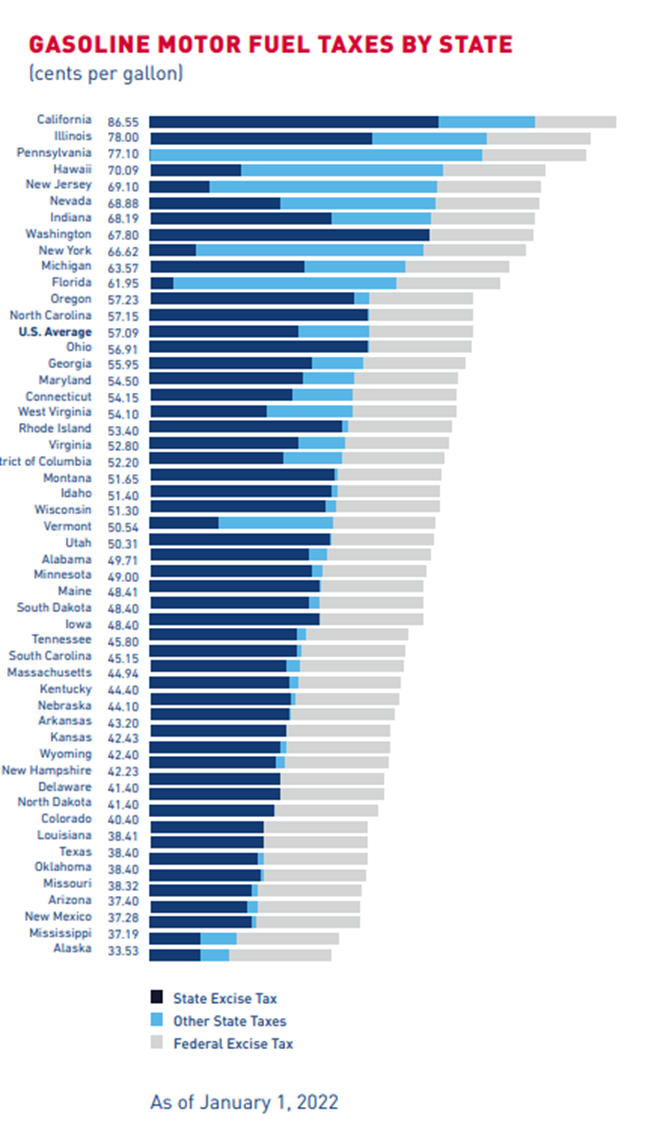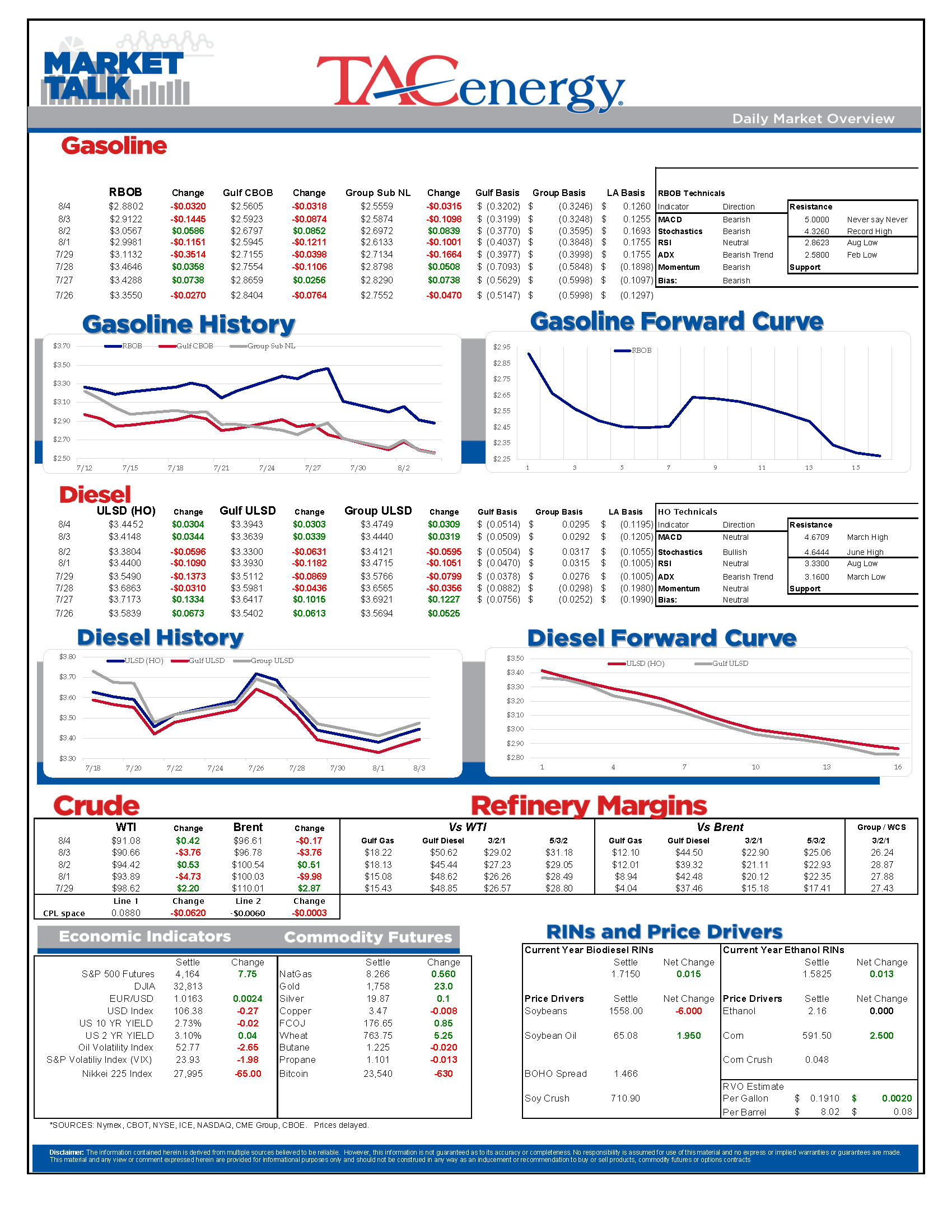Gasoline And Oil Futures Are Approaching 6 Month Lows This Week

Gasoline and Oil futures are approaching 6 month lows this week, following a harsh reminder Wednesday that slowing demand may be the only way to deal with the global energy supply shortage.
According to the DOE’s weekly report, gasoline consumption in the US has been weaker than the COVID summer of 2020 in 3 out of the past 4 weeks. While the weekly demand estimates are notoriously volatile, and in many cases unreliable in real time, there is no mistaking the market’s reaction to that data point as futures have dropped 25 cents in the past 24 hours.
Wednesday’s wipeout for RBOB futures, trumped Tuesday’s turnaround and has moved the technical outlook back into clearly bearish territory with a good chance we could see another 30 cent price drop in the next few weeks. It’s not just futures that are falling either, as NY Harbor gasoline prices have started their inevitable slide down an impossibly steep backwardation curve, with cash values down more than 40 cents as basis values start their return to reality. The selloff in both futures and cash markets assures that the streak of consecutive days of lower retail prices across the US will continue past 50.
If you’re still wondering why California retail prices are more than $1/gallon higher than many other states, take a look at the state fuel tax charts below (courtesy of the API), and then remember California ends up adding another 40-something cents per gallon in LCFS and Cap & Trade program costs on top of these official taxes.
Diesel inventories remain 24% below their average seasonal levels. PADDs 1 & 2 continue to have the lowest inventory levels relative to prior years, and the Midwest looks particularly vulnerable in the coming months as harvest demand ramps up, and Gulf Coast refiners have their hands full sending Barrels out to sea, rather than north as they’ve done for decades during this time. Speaking of which, Diesel exports have averaged north of 1.5 million barrels/day over the past month, meaning nearly 2 billion gallons of distillates have been sent overseas during this time. Remember that the next time someone asks why gasoline is so much cheaper than diesel in the next few months.
OPEC & Friends announced the smallest output increase they’ve ever made yesterday, .1mb/d for September with some reports suggesting this move was a political slap in the face to the US President, while the official press release suggests it was because of “severely limited availability of excess capacity”. It seems there’s a good chance they’re both right.
News & Views
View All
Energy Futures Are Caught Up In Headline Tug-O-War This Morning
Energy futures are caught up in headline tug-o-war this morning with Canadian oil production concerns and a positive US GDP report trying to push prices higher while sinking Chinese demand worries and Gaza ceasefire hopes are applying downward pressure. The latter two seem to be favored more so far this morning with WTI and Brent crude oil futures down ~45 cents per barrel, while gasoline and diesel prices are down about half a cent and two cents, respectively.
No news is good news? Chicago gasoline prices dropped nearly 30 cents yesterday, despite there not being any update on Exxon’s Joliet refinery after further damage was discovered Wednesday. Its tough to say if traders have realized the supply situation isn’t as bad as originally thought or if this historically volatile market is just being itself (aka ‘Chicago being Chicago’).
The rain isn’t letting up along the Texas Gulf Coast today and is forecasted to carry on through the weekend. While much of the greater Houston area is under flood watch, only two refineries are within the (more serious) flood warning area: Marathon’s Galveston Bay and Valero’s Texas City refineries. However, notification that more work is needed at Phillip’s 66 Borger refinery (up in the panhandle) is the only filing we’ve seen come through the TECQ, so far.
Premiums over the tariff on Colonial’s Line 1 (aka linespace value) returned to zero yesterday, and actually traded in the negatives, after its extended run of positive values atypical of this time of year. Line 1’s counterpart, Line 2, which carries distillates from Houston to Greensboro NC, has traded at a discount so far this year, due to the healthy, if not over-, supply of diesel along the eastern seaboard.
Click here to download a PDF of today's TACenergy Market Talk.

WTI And Brent Crude Oil Futures Are Trading ~$1.50 Per Barrel Lower In Pre-Market Trading
The across-the-board drawdown in national energy stockpiles, as reported by the Department of Energy yesterday, stoked bullish sentiment Wednesday and prompt month gasoline, diesel, and crude oil futures published gains on the day. Those gains are being given back this morning.
The surprise rate cut by the People’s Bank of China is being blamed for the selling we are seeing in energy markets this morning. While the interest rate drop in both short- and medium-term loans won’t likely affect energy prices outright, the concern lies in the overall economic health of the world’s second largest economy and crude oil consumer. Prompt month WTI and Brent crude oil futures are trading ~$1.50 per barrel lower in pre-market trading, gasoline and diesel are following suit, shaving off .0400-.0450 per gallon.
Chicagoland RBOB has maintained its 60-cent premium over New York prices through this morning and shows no sign of coming down any time soon. Quite the opposite in fact: the storm damage, which knocked Exxon Mobil’s Joliet refinery offline on 7/15, seems to be more extensive than initially thought, potentially extending the repair time and pushing back the expected return date.
There are three main refineries that feed the Chicago market, the impact from one of them shutting down abruptly can be seen in the charts derived from aforementioned data published by the DOE. Refinery throughput in PADD 2 dropped 183,000 barrels per day, driving gasoline stockpiles in the area down to a new 5-year seasonal low.
While it seems all is quiet on the Atlantic front (for now), America’s Refineryland is forecasted to receive non-stop rain and thunderstorms for the next four days. While it may not be as dramatic as a hurricane, flooding and power outages can shut down refineries, and cities for that matter, all the same, as we learned from Beryl.


